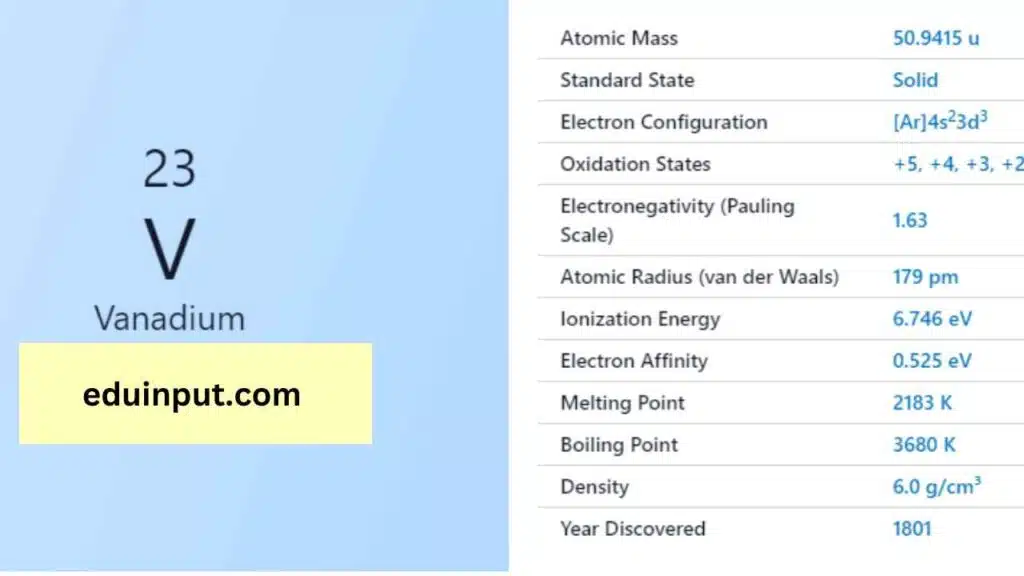Vanadium-Discovery, Properties, and Applications
Vanadium is a chemical element with the symbol ‘V’ and atomic number 23. It is a transition metal with a wide range of applications due to its unique properties. Vanadium was first discovered in 1801 by the Spanish mineralogist Andrés Manuel del Río, but it was later rediscovered in 1830 by Swedish chemist Nils Gabriel Sefström. The element is named after Vanadis, the Scandinavian goddess of beauty.

| Property | Value |
| Name | Vanadium |
| Symbol | V |
| Atomic number | 23 |
| Relative atomic mass (Ar) | 50.9415 |
| Standard state | Solid at 298 K |
| Appearance | Silvery grey metallic |
| Classification | Metallic |
| Period in the periodic table | 5 |
| Group name | (none) |
| Period in periodic table | 4 |
| Group in the periodic table | d |
| Shell structure | 2.8.11.2 |
| CAS Registry | 7440-62-2 |
Physical Properties
Vanadium is a silver-gray metal that is hard, ductile, and malleable. It has a high melting point and is resistant to corrosion. Vanadium is also a good conductor of electricity and has a low density compared to other transition metals.
Chemical Properties
Vanadium is a reactive element that readily forms compounds with other elements. It has multiple oxidation states, ranging from -1 to +5, and can form both simple and complex compounds. Vanadium compounds have unique colors, ranging from yellow to orange to green, and are used as pigments in ceramics and paints.
Facts
- Vanadium was first discovered in 1801 by the Spanish mineralogist Andrés Manuel del Río, but it was later rediscovered in 1830 by Swedish chemist Nils Gabriel Sefström.
- The element is named after Vanadis, the Scandinavian goddess of beauty.
- Vanadium has multiple oxidation states and can form a wide range of compounds, making it a versatile element with many applications.
Applications
Vanadium has a wide range of applications due to its unique properties. Some of its common uses include:
- Steel production: Vanadium is added to steel to increase its strength, durability, and corrosion resistance.
- Batteries: Vanadium redox batteries are used for energy storage in renewable energy systems.
- Catalysts: Vanadium compounds are used as catalysts in chemical reactions, such as the production of sulfuric acid.
- Pigments: Vanadium compounds are used as pigments in ceramics and paints.
Vanadium is a versatile transition metal with unique properties that make it useful in a wide range of applications. Its uses include steel production, batteries, catalysts, and pigments. Vanadium’s multiple oxidation states and ability to form complex compounds make it an important element in chemistry and materials science.







Leave a Reply